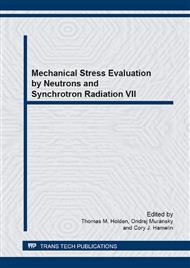[1]
R. C. Wimpory, P. Mikula, J. Šaroun, T. Poeste, J. Li, M. Hofmann, R. Schneider, Efficiency Boost of the Materials Science Diffractometer E3 at BENSC: One Order of Magnitude Due to a Horizontally and Vertically Focusing Monochromator, Neutron News 19 (2008) 16–19.
DOI: 10.1080/10448630701831995
Google Scholar
[2]
M. Boin, R. C. Wimpory, Upgrade Activities on the E3 Residual Stress Neutron Diffractometer, Mater. Sci. Forum 768-769 (2014) 31–35.
DOI: 10.4028/www.scientific.net/msf.768-769.31
Google Scholar
[3]
R. C. Wimpory, M. Boin, K. Rolfs, M. Chmielus, T. Fuß, R. Woracek, M. Schöbel, E3: A multipurpose instrument for strain, stress, texture and more, Meca Sens VI, Hamburg, Germany (2011)
Google Scholar
[4]
M. C. Smith, A. C. Smith, R. C. Wimpory, C. Ohms, B. Nadri, and P. J. Bouchard, "Optimising Residual Stress Measurements and Predictions in a Welded Benchmark Specimen: A Review of Phase 2 of the NeT Task Group 1 Single Bead on Plate Round Robin," in Proc. of the ASME Pressure Vessels and Piping Conference 2009 Volume 6: Materials and Fabrication, Parts A and B, ASME , 2010, 277–301
DOI: 10.1115/pvp2009-77157
Google Scholar
[5]
M. Hoelzel, W. M. Gan, M. Hofmann, C. Randau, G. Seidl, P. Jüttner, W. W. Schmahl, Rotatable multifunctional load frames for neutron diffractometers at FRM II—design, specifications and applications, Nuclear Instruments and Methods in Physics Research Section A: Accelerators, Spectrometers, Detectors and Associated Equipment 711 (2013) 101–105.
DOI: 10.1016/j.nima.2013.01.049
Google Scholar
[6]
R. Woracek, D. Penumadu, N. Kardjilov, A. Hilger, M. Strobl, R. C. Wimpory, I. Manke, J. Banhart, Neutron Bragg-edge-imaging for strain mapping under in situ tensile loading, J. Appl. Phys. 109 (2011) 093506.
DOI: 10.1063/1.3582138
Google Scholar
[7]
M. C. Smith, A. C. Smith, NeT bead-on-plate round robin: Comparison of residual stress predictions and measurements, Int. J. Pres. Ves. Pip. 86 (2009) 79–95.
DOI: 10.1016/j.ijpvp.2008.11.017
Google Scholar
[8]
X.-L. Wang, S. Spooner, C. R. Hubbard, Theory of the Peak Shift Anomaly due to Partial Burial of the Sampling Volume in Neutron Diffraction Residual Stress Measurements, J. Appl. Cryst. 31 (1998) 52–59.
DOI: 10.1107/s0021889897008261
Google Scholar
[9]
T. Gnaeupel-Herold, H. J. Prask, R. J. Fields, T. J. Foecke, Z. C. Xia, U. Lienert, A synchrotron study of residual stresses in a Al6022 deep drawn cup, Mater. Sci. Eng., A 366 (2004) 104–113.
DOI: 10.1016/j.msea.2003.08.059
Google Scholar
[10]
R. C. Wimpory, U. Wasmuth, J. Rebelo-Kornmeier, M. Hofmann, The Effect of Grain Size on Strain Determination Using a Neutron Diffractometer, Mater. Sci. Forum 638-642 (2010) 2405–2410.
DOI: 10.4028/www.scientific.net/msf.638-642.2405
Google Scholar
[11]
T. Pirling, Neutron Strain Scanning at Interfaces: An Optimised Beam Optics to Reduce the Surface Effect, Mater. Sci. Forum 347-349 (2000) 107–112.
DOI: 10.4028/www.scientific.net/msf.347-349.107
Google Scholar
[12]
T. Fuß, R. C. Wimpory, M. Klaus, C. Genzel, Bridging Gaps in Surface Zone Residual Stress Analysis Using Complementary Probes for Strain Depth Profiling, Mater. Sci. Forum 681 (2011) 411–416.
DOI: 10.4028/www.scientific.net/msf.681.411
Google Scholar
[13]
J. Šaroun, J. R. Kornmeier, M. Hofmann, P. Mikula, M. Vrána, Analytical model for neutron diffraction peak shifts due to the surface effect, J. Appl. Cryst. 46 (2013) 628–638.
DOI: 10.1107/s0021889813008194
Google Scholar
[14]
C. Randau, U. Garbe, H.-G. Brokmeier, StressTextureCalculator : a software tool to extract texture, strain and microstructure information from area-detector measurements, J. Appl. Cryst. 44 (2011) 641–646.
DOI: 10.1107/s0021889811012064
Google Scholar
[15]
M. Schöbel, J. Jonke, H. P. Degischer, V. Paffenholz, A. Brendel, R. C. Wimpory, M. Di Michiel, Thermal fatigue damage in monofilament reinforced copper for heat sink applications in divertor elements, J. Nucl. Mater. 409 (2011) 225–234.
DOI: 10.1016/j.jnucmat.2010.12.242
Google Scholar


